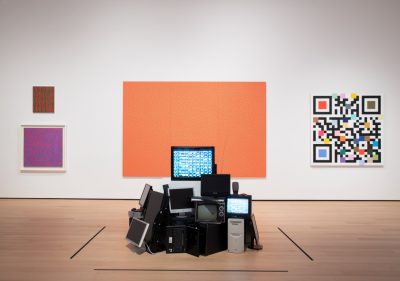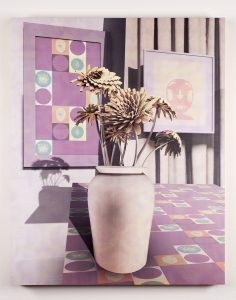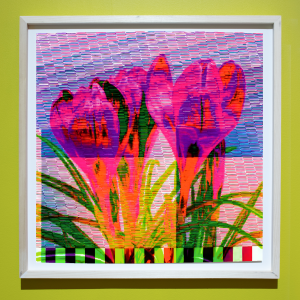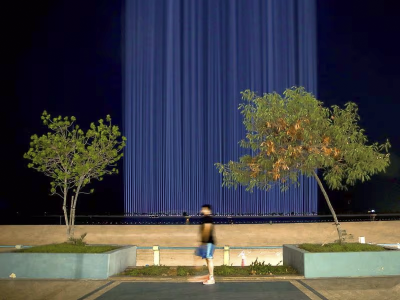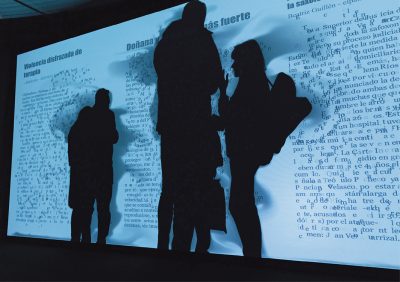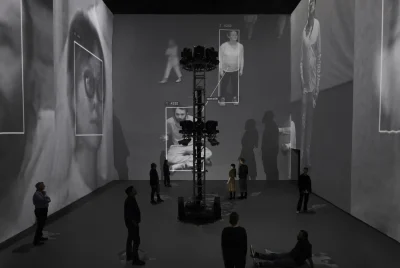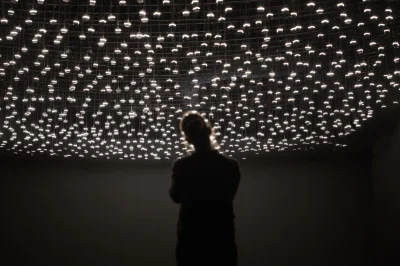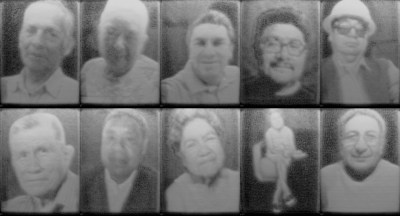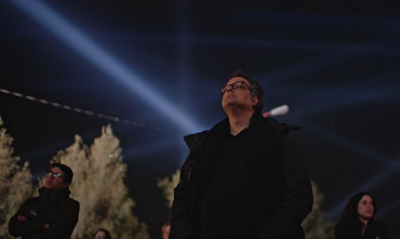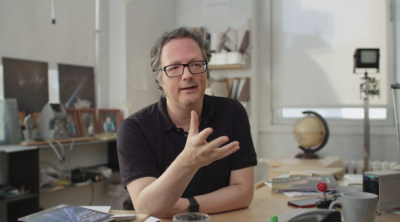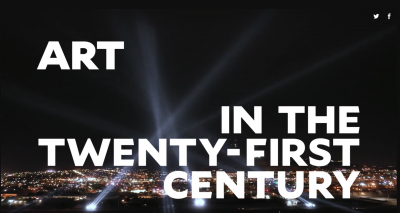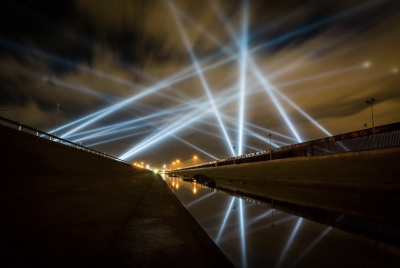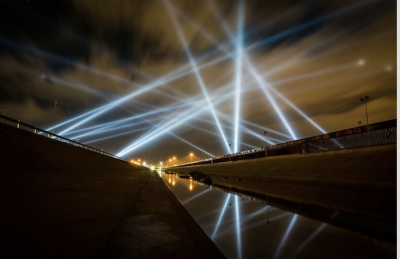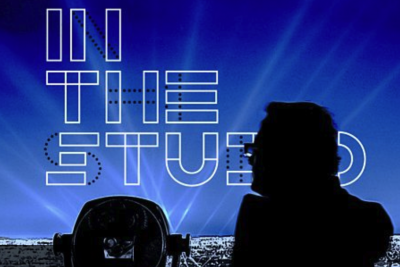bitforms gallery is pleased to announce its fourth solo exhibition with Mexican-Canadian artist Rafael Lozano-Hemmer. The exhibition features the United States premiere of two projects: Voice Array, a participatory environment that debuted last Fall in Sydney, Australia, at the Museum of Contemporary Art; and Last Breath, which was part of the 11th Bienal de la Habana. Concurrent with the New York exhibition, on September 20, Lozano-Hemmer will also unveil Open Air, a new commission by the Association for Public Art in Philadelphia.
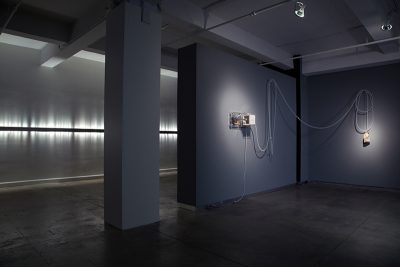
Rafael Lozano-Hemmer
Voice Array
September 6 – October 20, 2012
bitforms gallery is pleased to announce its fourth solo exhibition with Mexican-Canadian artist Rafael Lozano-Hemmer. The exhibition features the United States premiere of two projects: Voice Array, a participatory environment that debuted last Fall in Sydney, Australia, at the Museum of Contemporary Art; and Last Breath, which was part of the 11th Bienal de la Habana. Concurrent with the New York exhibition, on September 20, Lozano-Hemmer will also unveil Open Air, a new commission by the Association for Public Art in Philadelphia.
Since his emergence in the 1990s, Lozano-Hemmer has mixed the disparate fields of digital media, robotics, medical science, performance art, and lived experience into interactive artworks. Probably best known for his large-scale “Antimonuments”, which challenge traditional notions of site-specificity, he focuses on the idea of creating relationship-specific work through connective interfaces. Often employing vanguard technologies, many of his projects utilize robotics, custom software, projections, internet links, cell phones, sensors, LEDs, cameras, and tracking systems.
The communal spaces that Lozano-Hemmer creates are an experiment in public authorship. Technology in his work activates seamless “encounters of art, self and the kinetic force of collective memory,” writes Claudia Arozqueta (Artforum.com, Jan 2012). As a conductor of this experience, he seduces the audience into participation, using tactile sensation, repetition and the simulated presence of an individual.
At the gallery entrance, Last Breath is a robotic installation that stores and circulates the breath of a person forever, between a bellows and a brown paper bag. The apparatus is automatically activated 10,000 times per day, the typical respiratory frequency for an adult at rest. With each breath the piece generates quiet sounds from the bellows, the motor and the crackling of the paper bag. The piece also sighs 158 times a day. For the exhibition in New York, the piece is a biometric portrait of Cuban singer Omara Portuondo. A short video of her recording her breath into the device is shown on a small screen mounted to the wall.
Filling the gallery’s far wall, Voice Array is a construction for vocal improvisation that uses blinking LEDs and a customized intercom system of audio playback and recording. Capturing hundreds of voices and translating each one into a series of light flashes, the piece stores a unique pattern as a loop in the first light of the array, until the next participant speaks into the intercom. Each new recording is pushed along its long horizontal band of LEDs, as sounds of the voices gradually accumulate. When the first voice reaches the other side of the piece, the participant’s phrase is once again released as sound, punctuated by the staggering pulsation of all the lights in tandem. The ever-changing voices stored by the piece play back through a directional speaker, during moments of less activity.
Specially Commissioned Opening Night Performance:
The exhibition’s opening will feature a performance by vocal percussionist Rahzel, The Godfather of Noyze, who will explore Lozano-Hemmer’s “Voice Array” within the musical context of human beatboxing. Since its beginnings in the early 1980s hip-hop community, beatboxing has played creatively with the interface between machines, the body and music. A direct means of handling rhythm and percussion, it is typically associated with turntablism, mixing, the drum machine, scat and improv.
The collaboration on September 6, 2012, with Lozano-Hemmer’s sound and light sculpture, “Voice Array”, is Rahzel’s first foray into interactive and visual art performance. “Beatboxing really means something to me,” says Rahzel. “The beatbox is like your heart beating, and you can’t really live without a heartbeat.” Initially
continues on next page…
conceived of as a project that visualizes the human voice and communication, this special performance blends a synchronous light show with Rahzel’s dynamic repertoire. It also captures musical elements of dub and improvisation.
Afterward, the sculpture will continue to recycle this material and additionally collect loops of time and light from individual audience members – further blurring the categorical definitions of the stage, intimacy and spectacle. “As people populate the work and speak into it, and ultimately leave their recorded message behind, the project becomes alive. So in this sense, my artistic practice is about crowd-sourcing the content,” says Lozano- Hemmer, “The experience of participation is to reconsider one’s notion of community- which is by its very definition, a reductive, essentialist and problematic division.”
SELECTED CONCURRENT EXHIBITIONS
Open Air: September 20 – October 14, 2012; Association for Public Art; Philadelphia, PA
Open Air is a large, interactive public art installation that activates 24 robotic searchlights placed along a half-mile section of the Benjamin Franklin Parkway – creating enormous three-dimensional light formations in the night sky. Using a free custom-made mobile app designed by the artist, the voices and GPS positions of participants generate its content, in a ‘crowdsourced’ experience of public space and urban connection. The project will activated each evening from 8 PM to 11 PM.
Homographies: September 1, 2012 – January 1, 2013; SF MoMA, San Francisco, CA
Homographies is an interactive installation that employs an overhead grid of fluorescent tubes programmed to rotate in response to visitors’ movements. It is part of a group exhibition organized by Joseph Becker, Field Conditions, which address relationships between conceptual art and theoretical architecture, specifically concerning the subject of fields.
Frequency and Volume: November 3, 2012 – February 3, 2013; SF MoMA, San Francisco, CA
In a solo exhibition that is part of the ZERO1 Biennale, Frequency and Volume (2003) uses radio equipment to allow participants to tune in and listen to different radio frequencies by using their own bodies.
Cardinal Directions: August 31 – September 30, 2012; Instituto Valenciano de Arte Moderno; Valencia, Spain
Part of a group exhibition at IVAM, Transverso: Instalaciones y nuevos medios en Iberoamérica, the installation Cardinal Directions uses a rotating surveillance monitor to display a geo-localized version of Vicente Huidobro’s epic poem “Altazor”.
Pulse Park: August 16 – September 30, 2012; Ruhr Triennial; Bochum, Germany
Premiered in 2008 at Madison Square Park in New York, Pulse Park is a matrix of light beams whose intensity is entirely modulated by a sensor that measures the heart rate of participants. The resulting effect is the visualization of vital signs, arguably our most symbolic biometric, in an urban scale.
Trackers: October 18 – December 23, 2012; Fundación Telefónica, Buenos Aires, Argentina
The solo exhibition Trackers was conceived as an environment that mixes detection technologies and audiovisual explorations in real time. Featuring more than ten works by Lozano-Hemmer, it aims to create critical and complicit experiences using ambiguity, alterity, repetition and performance.
BIOGRAPHIES
Rafael Lozano-Hemmer (b. 1967, Mexico) is an electronic media artist whose recent projects include large-scale public installations for the 2010 Winter Olympics in Vancouver, Canada; the Madison Square Park Conservancy in New York, the 50th Anniversary of the Guggenheim Museum in New York; and the millennium celebrations at Zócalo Square in Mexico City. Recently the subject of a solo exhibition at the Sydney Museum of Contemporary Art, he was the first artist to officially represent Mexico at the Venice Biennale with an exhibition at Palazzo Van Axel in 2007. Collections holding his work include the Museum of Modern Art, New York; Tate Modern, London, UK; San Francisco Museum of Modern Art, CA; Art Gallery of Ontario, Toronto, Canada; Cisneros Fontanals Art Foundation, Miami, FL; Colección Jumex, Mexico City, Mexico; Museo Universitario Arte Contemporáneo (MUAC), Mexico City, Mexico; DAROS Latinamerica Collection, Zurich, Switzerland; Borusan Contemporary Art Collection, Istanbul, Turkey; Museo Nacional Centro de Arte Reina Sofía, Madrid, Spain; and the Musée d’art contemporain de Montréal, Canada, among others.
Rahzel (b. Hollis, Queens, NY) is a two-time Grammy award winning artist, beat boxer, actor and writer who has redefined the art of vocal percussion and sound effects. Creating virtual orchestras using spoken word and the pure phenomenon of voice, his work has toured internationally to more than 350 cities. He is one of the world’s most recognizable vocal percussionists and was a founding member of the band The Roots.
